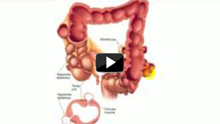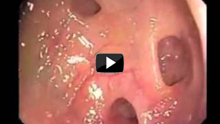Diverticulosis
Presence of colonic diverticula is common in middle-aged people in the western world. Recently, we have observed an increasing number of patients who develop diverticula in their 30ʼs. Usually (although not universally), diverticula develop in people with some history of constipation, or in those with a long history of consumption of diet high in calories and nutrients. On the contrary, it is less common among people who tend to consume high-fiber diets. It seems that the former group tends to form feces which are of hard consistency and small volume, as opposed to the latter group (soft consistency and larger volume). When the fecal contents are small and hard, the colon tries hard to expel them, so the pressure within the colon builds high and outpouchings (diverticula) may develop.
While the mere presence of diverticula is called diverticulosis, their inflammation and infection is called diverticulitis. Diverticulitis, in its milder and more common form requires hospitalization, intravenous fluids and antibiotics for a few days. However, in its more severe form, it may lead to a life-threatening intra-abdominal infection with colon perforation and fecal peritonitis. This condition is a true surgical emergency, it may require temporary colostomy (and then another operation to take-down the colostomy and reconnect the bowel), and management in the Intensive Care Unit.
Usually, after the development of two mild episodes of diverticulitis, one should consider the surgical removal of the diverticula-bearing portion of the colon in order to prevent a subsequent, more severe episode with potential catastrophic complications. The resection of the involved segment of the colon can be performed laparoscopically during a short hospitalization and minimal postoperative discomfort. This approach relieves the symptoms, prevents future complications, and is especially relevant to younger patients with a long life expectancy, which is of course associated with an even greater risk of complications if it is left untreated.















